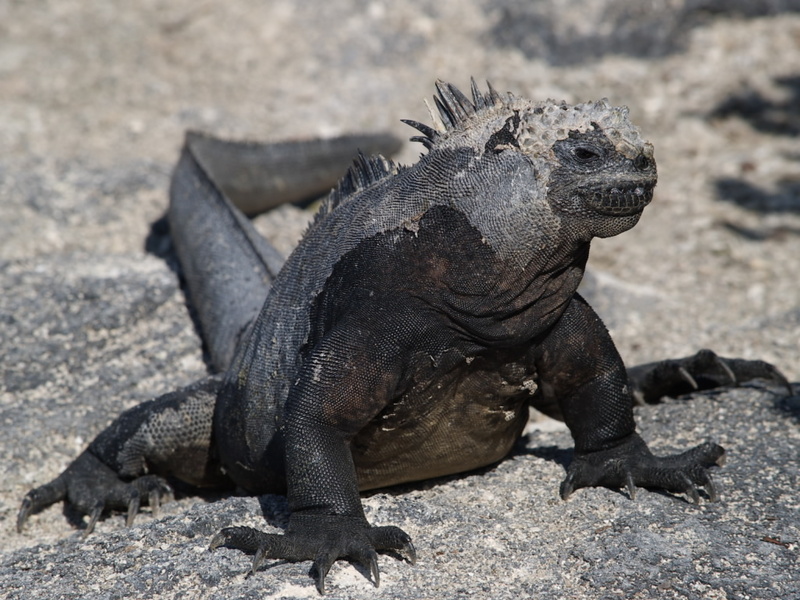|
| 질의: Common teal | 결과: 120번째/161 | |
Marine Iguana (Amblyrhynchus cristatus) - Wiki
| 제목: | Marine Iguana (Amblyrhynchus cristatus) - Wiki
| |

| 해상도: 1024x768
파일크기: 321504 Bytes
촬영일: 2004:04:28 16:51:00
사진기: E-1 (OLYMPUS CORPORATION )
F number: f/2.8
Exposure: 1/800 sec
Focal Length: 182/1
등록시간: 2007:09:25 20:07:30
|
ERROR : Server Busy(-1105)
ERROR : Server Busy(-1105)
Marine Iguana (Amblyrhynchus cristatus) - Wiki
Marine Iguana
From Wikipedia, the free encyclopedia
[Photo] Marine iguana from Philip Greenspun's Weblog: Marine Iguana. Date 28 April 2004. Image URL: http://en.wikipedia.org/wiki/Image:Marineiguana03.jpg
The Marine Iguana (Amblyrhynchus cristatus) is an iguana that has the unique ability among modern lizards to live and forage in the sea. It is found only on the Galapagos Islands, but has spread to all the islands in the archipelago, and is sometimes called the Galapagos Marine Iguana. It mainly lives on the rocky Galapagos shore, but can also be spotted in marshes and mangrove beaches.
Description
On his visit to the islands, Charles Darwin was revolted by the animals' appearance, writing:The black Lava rocks on the beach are frequented by large (2-3 ft) most disgusting clumsy Lizards. They are as black as the porous rocks over which they crawl & seek their prey from the Sea. I call them 'imps of darkness'. They assuredly well become the land they inhabit. In fact, Amblyrhynchus cristatus is not always black; the young have a lighter coloured dorsal stripe, and some adult specimens are grey. The reason for the sombre tones is that the species must rapidly absorb heat to minimize the period of lethargy after emerging from the water. They feed almost exclusively on marine algae, expelling the excess salt from nasal glands while basking in the sun, and the coating of salt can make their faces appear white. In adult males, coloration varies with the season. Breeding-season adult males on the southern islands are the most colorful and will acquire reddish and teal-green colors, while on Santa Cruz they are brick red and black, and on Fernandina they are brick red and dull greenish.
Another difference between the iguanas is size, which is different depending on the island the individual iguana inhabits. The iguanas living on the islands of Fernandina and Isabela (named for the famous rulers of Spain) are the largest found anywhere in the Gal??pagos. On the other end of the spectrum, the smallest iguanas are found on the island on Genovesa.
Adult males are approximately 1.3 m long, females 0.6 m, males weigh up to 1.5 kg.
Behaviour
As a cold blooded animal, the marine iguana can spend only a limited time in the cold sea, where it dives for algae. However, by swimming only in the shallow waters around the island they are able to survive single dives of up to half an hour at depths of more than 15 m. After these dives, they return to their territory to bask in the sun and warm up again. When cold, the iguana is unable to move effectively, making them vulnerable to predation, so they become highly aggressive before heating up (since they are unable to run away they try to bite attackers in this state). During the breeding season, males become highly territorial. The males assemble large groups of females to mate with, and guard them against other male iguanas. However, at other times the species is only aggressive when cold.
Marine iguanas have also been found to change their size to adapt to varying food conditions. During El Ni??o conditions when the algae that the iguanas feed on was decreased for a period of two years, some were found to decrease their length by as much as 20%. When food conditions returned to normal, the iguanas returned to their pre-famine size. It is speculated that the bones of the iguanas actually shorten as a shrinkage of connective tissue could only account for a 10% length change.
Conservation
This species is completely protected under the laws of Ecuador, and is listed under CITES Appendix II. El Ni??o effects cause periodic declines in population, with high mortality, and the marine iguana is threatened by predation by exotic species. The total population size is unknown, but is, according to IUCN, at least 50,000, and estimates from the Charles Darwin Research Station are in the hundreds of thousands.
Threats
The marine iguanas have not evolved to combat newer predators. Therefore, cats and dogs eat both the young iguanas and dogs will kill adults due to the iguanas' slow reflex times and tameness. Dogs are especially common around human towns and can cause tremendous predation. Cats are also common in towns, but also occur in numbers in remote areas, where they take a toll on iguanas.
Evolution
Researchers theorize that land and marine iguanas evolved from a common ancestor since arriving on the islands from South America, presumably by driftwood. It is thought that the ancestral species inhabited a part of the volcanic archipelago that is now submerged.
A second school of thought holds that the Marine iguana may have evolved from a now extinct family of sea-going reptiles.
http://en.wikipedia.org/wiki/Marine_Iguana
| The text in this page is based on the copyrighted Wikipedia article shown in above URL. It is used under the GNU Free Documentation License. You may redistribute it, verbatim or modified, providing that you comply with the terms of the GFDL. |
|
댓글 |
|---|
| | 손님 |
|
Scientific Name: Amblyrhynchus cristatus Bell, 1825
Common Names: Fernandina Marine Iguana, Galapagos Marine Iguana, Galápagos Marine Iguana, Marine Iguana, Sea Iguana; [French] Amblyrhynche à crête, Iguane marin; [Spanish] Iguana Marina
Synonym:
Amblyrhynchus cristatus STEINDACHNER 1876
Amblyrhincus ater DUMÉRIL & BIBRON 1837
Amblyrhincus cristatus DUMÉRIL & BIBRON 1837
Amblyrhincus Demarlii DUMÉRIL & BIBRON 1837
Hypsilophus cristatus FITZINGER 1843
Hypsilophus ater FITZINGER 1843
Iguana Cristatus GRAY 1831
Iguana Ater GRAY 1831
Oreocephalus cristatus GRAY 1845 |
^o^
동물그림창고 똑똑전화 누리집
^o^
|
|
|

